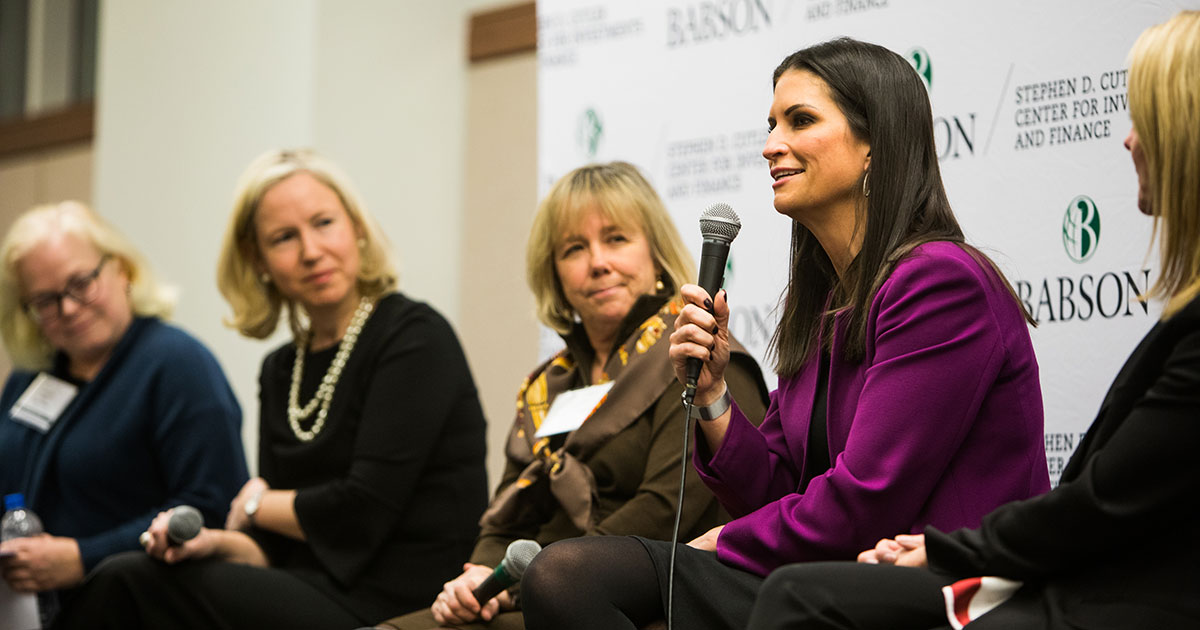We Need More Women in Finance

Kate Jaspon ’98 was working as a senior manager auditor at KPMG when she received a call from a client about a possible job opening.
On a whim, she went on an interview, and later accepted a position as an assistant controller. Years later at the same company, the move ended up being one of several significant steppingstones on her way to her current role as chief financial officer of Dunkin’ Brands.
How did she get there? Like many women in finance who have become leaders, Jaspon traces her path back to hard work, confidence, and courage. “I built a lot of relationships, I never burned bridges, I networked like crazy,” she said.
It’s these qualities and tactics that were echoed by Karen Snow ’93, Cappy Daume, and Sarah Burley Reid at a panel last week on incorporating more women into leadership roles in the financial services industry, moderated by Professor Jennifer Bethel and staged by the Cutler Center for Investments and Finance.
Why We Need Women in Finance
Despite progress in recent years, financial services is still dominated by men. Women represent just one of every five positions held in the industry.
Daume, managing director for asset management of The Davis Companies, described the challenges she has faced sitting on several committees where women are outnumbered. The benefits of having more women at the table, she said, include bringing “a different perspective and team collaboration.”
According to new research from Morningstar, only 11 percent of fund managers in the United States in 2019 were women. That number has declined in recent years, as in 2000, women represented 19 percent of passive fund managers and 13 percent of active fund managers.
“People from different backgrounds bring different views,” added Burley Reid, a consultant at Spencer Stuart. “Different views lead to better business outcomes.”
A push for greater diversity must begin with leadership. It starts with providing equal pay and opportunity, as well as a more inclusive environment, said Jaspon and Snow, senior vice president and head of East Coast listings and capital services for Nasdaq.
“What will help us is when society becomes more accepting of stay-at-home dads, or of women having nannies for help at home, and women don’t have that pressure of ‘am I choosing work (or family),’ ” Jaspon said.
How They Ascended to Leadership Roles
Climbing the competitive management ladder is a process Snow has mastered.
Earlier in her career before annual compensation, Snow, seeking both opportunity and merit, would check in with her managers about the state of the company, in a practice which she said left her “never disappointed.”
As a woman who has held noteworthy roles on Wall Street, she said little will come to those who don’t act.
“If you don’t ask for it, you’re not getting it,” she said. “You have to do it in a way that shows your worth. ‘Here’s all the things I did this year, and I expect to be recognized for it.’ ”
Courage, too, can’t be overlooked, said Burley Reid.
“If you’re interested in something, go for it,” she said. “You can’t expect other people around you are going to make it better for you.”
Snow’s advice to dozens of students in the audience was a reminder to plan a future that will open possibilities.
“It’s really up to you to pick the right career choice out of school that will open more doors. You want to be strategic,” she said. “You’re getting an incredible education. Babson has served me so well. But, it doesn’t end here.”
Posted in Community






